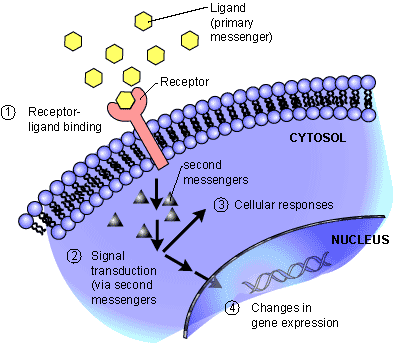No, not you! I was talking about your cells! That's right, cells are expressive. Cells are opinionated, and cells effectively convey their inner most feelings to achieve and communicate a specific state of being. Well... sort of.
A cell expresses itself through its genes. We have already learned all about genes and how they are strings of 'words' that make up DNA. We know that genes encode proteins that do the work in the cell. We know that the specific genes a cell uses determines it's fate (i.e. a liver cell uses genes important for metabolism while a white blood cell uses genes for immunity). But what we haven't covered yet is how the cell knows which genes to use and which genes not to use.
This is not an easy topic to cover in a short blog post. The convoluted process of using genes (which is called 'gene expression' - hence my oh-so-clever title) involves several complex pathways that are integrated from all parts of the cell. Deconstructing this process can involve some very heavy science. But we are not here for heavy science, we are here for a fun, easy and educational read. And I will try to make this as painless as possible.
 |
| Sources of signals that are used to communicate between cells. This includes short-range and long-range signals. |
Once a signal is received by a cell a sequence of events is initiated like a classical domino effect. The sequence of events is called 'signal transduction'. Essentially, the signal proteins connects with another protein in order to activate it, this active protein might turn off another protein which moves through the cell to connect with a different protein and another protein and another ... until finally the pathway of proteins leads to a specific gene being turned on or off. All of the work is done by a sequence of proteins. The specific set of proteins that are active in any given cell determine which genes that cell turns on and expresses.
 |
| Signals from the environment are sensed by the cell. The specific signal activates a specific pathway of proteins that control the expression of specific genes. |
What? Wait a second! I am sure right now you are saying, "WTF Ashley! Like... I mean... like you just finished telling me that genes make proteins, and now you are saying that proteins control genes. Like OMG! Like. What are you talking about?" To this I say, "Yes, I know this is all very confusing (especially if you talk like that!), and I don't know if I can make it less confusing (considering your pea-sized brain!), but I will try."
Lets give a simple example. Lets say that at the beginning of a cell's life it turns on all of its genes and has all of its proteins around. This cell can do just about anything. Then, a couple of hours later, a neighbouring cell sends out a signal telling that cell how to behave. The specific signal activates a specific pathway of proteins. The sequence of proteins eventually instruct the cell to stop making proteins for immunity (i.e. they turn off immunity genes) and start making more proteins for metabolism. The result: the cell uses liver genes, makes liver proteins and acts like a liver cell. Viola!
However, this example is a little over-simplified. What the example fails to address is that most cells don't start off making all their proteins (thanks to epigenetics- a topic for another blog!) and cells have to integrate dozens of different signals at any given time. This is because cells exist in large 'communities' and they are constantly receiving conflicting signals from their different neighbours. That is why, it is the specific set of proteins that are active in any given cell at any given time that determine which genes that cell turns on and how that cell behaves. Essentially, it is a complex math problem. Lets say that signal A turns on pathway A and signal B turns on pathway B. It depends on how much of either signal is present that determines which pathway gets turned on. As I warned you, this is all very complicated!
 |
| This diagram is a nice example of the complexity of signal transduction pathways and how multiple signals are integrated in a cell at any given time. By responding to all the different signals in the environment the cell knows which genes to turn on and which genes to turn off. |
In fact, scientists have been struggling to understand signaling pathways since the beginning of modern science! There are many researchers who have dedicated their entire lives to figuring out the details of a single pathway. And we still know very little about these pathways. For instance, one incredibly important signal protein (called Wnt) has been studied extensively by dozens of famous scientists, and although we have an idea of the protein pathway it activates and we have some ideas about the changes it causes in some types of cells we still don't know which genes it turns on and off in the cells! To be frank, there are very few pathways that we have successfully mapped.
Currently, a lot of research surrounds this topic and aims to discover exactly how cells integrate all the different signals in their environment, and how different combination of signals affect different types of cells. By understanding how a cell expresses itself we can one day learn how to control a cell. Because it's the set of genes a cell uses that determines how the cell behaves, all we need to do is change the genes being expressed in order to change the behaviour of the cell. This can be very important for treating injuries and curing diseases.
This video gives an upclose and personal view on how signals are moved through cells.

No comments:
Post a Comment